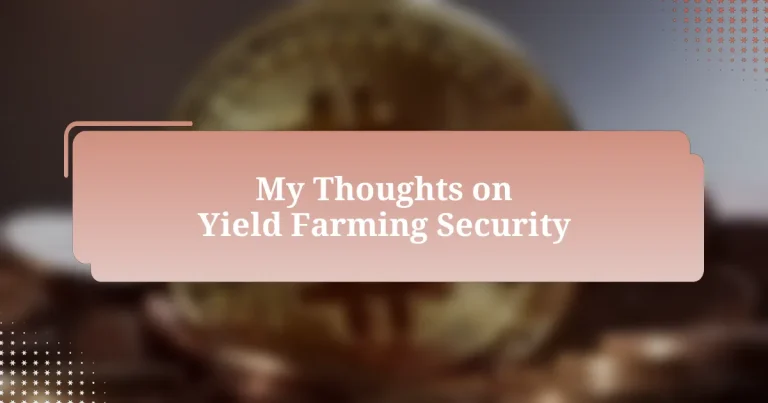Key takeaways:
- Yield farming allows users to earn rewards by lending or staking cryptocurrencies, leveraging their assets for potentially high returns.
- Decentralized finance (DeFi) removes traditional financial institutions, offering transparency and accessibility through open-source protocols.
- Security is vital in DeFi, as vulnerabilities in smart contracts can lead to significant losses, emphasizing the importance of thorough audits.
- Yield farming carries risks such as impermanent loss and potential fraud, making it essential to evaluate project teams and technology integrity.
What is yield farming
Yield farming is a practice in decentralized finance where individuals lend or stake their cryptocurrencies to earn rewards, often in the form of additional tokens. I remember my first experience with yield farming; it felt like planting seeds in a garden, anxiously waiting to see how they would grow. Isn’t it fascinating how just by providing liquidity, you can cultivate a whole new source of income?
At its core, yield farming allows users to maximize their returns by leveraging their existing assets. Many times, I’ve pondered how traditional banking pales in comparison to the potential gains obtainable in decentralized platforms. Why settle for minimal interest rates when the world of DeFi offers such opportunities that can significantly boost one’s holdings?
The process itself often involves complexities such as smart contracts, which automatically execute transactions based on pre-defined conditions. I can’t help but feel a thrill when navigating through these digital landscapes, yet I also recognize that this excitement brings with it certain risks. Have you ever considered how the allure of high returns might overshadow the need for caution in this rapidly evolving space?
Understanding decentralized finance
Decentralized finance, or DeFi, revolutionizes the way we perceive financial services, removing the traditional gatekeepers like banks and financial institutions. I still remember the first time I used a decentralized exchange; it felt empowering to have direct control over my assets without the interference of a third party. How liberating is it to think that our financial future lies in our own hands?
One of the most exciting aspects of DeFi is its potential for transparency and accessibility. Unlike traditional systems, where fees can be obscured and access may be limited, I’ve found that DeFi protocols often operate in an open-source environment. This openness makes it easier for anyone to participate, regardless of their geographical location or financial background. Have you ever thought about how this democratization of finance could create opportunities for those who have been left out of traditional banking systems?
Moreover, I find it intriguing that intelligent contract technology underpins many DeFi applications. These self-executing contracts not only streamline transactions but also reduce the likelihood of human error. I often wonder if this innovation is just the first step toward a future where our entire financial infrastructure operates seamlessly on decentralized platforms. The possibilities seem endless, don’t they?
Importance of security in DeFi
When it comes to decentralized finance, security is paramount. I’ve personally experienced the anxiety of investing in a new protocol, only to hear about security breaches shortly after. Those incidents serve as stark reminders that while DeFi offers innovative solutions, the safety of our assets should never be compromised. How can we truly embrace the benefits of DeFi if we’re not certain our investments are secure?
It’s fascinating to me how a single loophole in smart contracts can lead to significant losses. For example, I once read about a protocol that lost millions due to an oversight in its code. This experience taught me the importance of conducting thorough audits and understanding the technology we engage with. Isn’t it reassuring to know that the more we prioritize security, the more we can enjoy the advantages of decentralized finance?
Furthermore, I can’t help but consider how trust plays a crucial role in our financial decisions. In traditional finance, trust is often placed in institutions, whereas in DeFi, it hinges on the technology itself. I remember a conversation with a friend who was hesitant to dive into DeFi because of security concerns. It struck me that building a secure and transparent environment is essential for broader adoption. How can we foster that trust without addressing security head-on?
Common risks in yield farming
Yield farming, while promising high returns, carries significant risks that can catch even experienced investors off guard. One of the most alarming risks is the vulnerability of smart contracts. A couple of months back, I came across a project where a smart contract glitch resulted in users being unable to access their funds for days. This incident really drove home the point for me: without appropriate audits, we could be placing our trust in a ticking time bomb.
Another concern I often reflect on is the risk of impermanent loss. I remember stepping into yield farming with enthusiasm, only to see a sharp drop in the value of paired tokens. This left me questioning my decision. It’s a stark reminder that price volatility doesn’t just affect your immediate returns; it can fundamentally alter your investment’s worth over time. Why should we ignore this risk when it can so significantly impact our overall strategy?
Lastly, the involvement of malicious actors can’t be underestimated. I once learned of a project that fell victim to a rug pull, where developers siphoned off funds, leaving investors high and dry. This made me reconsider how I evaluate the integrity of the teams behind projects. How can we safeguard ourselves against such betrayal in an environment where transparency is often obscured? Understanding who stands behind a project is just as crucial as the technology itself.

